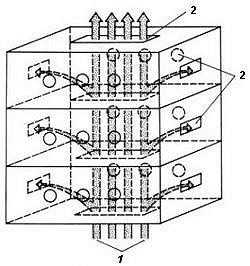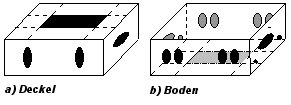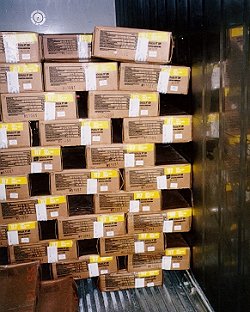The entry of external heat into the container through its walls, floor and roof, and the heat which is produced by the cargo itself and has to be removed. In this case, air must circulate not only around the cargo but also throughout the cargo (see Figs. 102 and 103).
 |
Figure 102: Vertical air flow through perforated cartons 1 - vertically flowing cooling air 2 - perforations in cartons |
 |
| Figure 103: Folding telescope cartons for bananas, Cavendish variety, from Ecuador |
In the case of chilled goods, respiration heat and packaging type are of considerable significance. The perforation openings in the packaging differ in size and/or number depending on the respiration heat (see Section 15.4).
When packing a container with chilled goods (fruit, vegetables), it is important for the cooling air to be able to flow unhindered through the perforation openings and gaps between the cartons, i.e. the cartons must be stowed precisely "in line" (see Fig. 106).
 |
Figure 106: Ventilated stowage: This is the best possible type of stowage for chilling plus goods or chilled beef. This well-ventilated stowage method ensures that cooling air circulates around each carton and a uniform chilling temperature may thus be achieved. Photo: Förster/Ahrens [12] |
If deep-frozen meat is at its optimum temperature when loaded, it is not necessary to leave these gaps during stowage. All that is necessary with frozen goods is for the subzero temperatures to be maintained around the stowed cargo in the floor, side and ceiling areas.
This is ensured by the corrugations in the side walls, the space in the ceiling area and the gratings in the floor area.